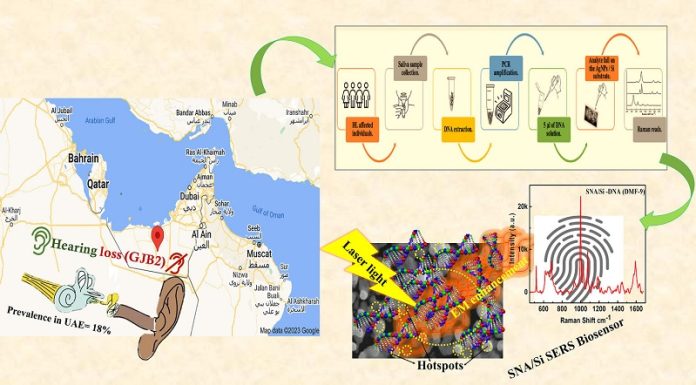
A team of scientists from the University of Sharjah has invented a cutting-edge biosensor capable of detecting gene mutations responsible for hearing loss.
This innovative sensor, made with nanoparticles and nanoarrays of silver, offers precise and rapid diagnosis of not only hearing loss genes but also other diseases like cancer, Alzheimer’s, and thalassemia.
The details of this breakthrough are published in the International Journal of Biological Macromolecules.
The team, led by Professor Mounir Gaidi of Sharjah University, emphasizes the sensor’s potential to revolutionize global medical diagnostics.
“Our innovation could transform diagnostic devices by integrating Surface-Enhanced Raman Spectroscopy (SERS) biosensors, allowing for the screening of numerous infections,” says Professor Gaidi.
SERS is an analytical technique used to identify, detect, and diagnose molecules at very low concentrations. The new biosensor enhances SERS, making it a more powerful and faster detection tool.
The rapid detection capability of this sensor is vital not only for identifying hearing loss genes but also for predicting deadly diseases like cancer and Alzheimer’s.
The development of this biosensor comes as a significant advancement in the medical field, where there is still much debate on how to best utilize SERS for disease detection.
“In our research paper, we designed a simple, cost-effective SERS biosensor to detect the deafness-causing gene mutant DNA from the saliva of affected individuals,” says Professor Gaidi.
The new biosensor surpasses existing diagnostic tools in terms of speed, stability, and sensitivity. It can detect various gene mutations with high accuracy, making it a valuable addition to clinical diagnostics. “Our study aims to create a library of deafness mutations to facilitate quick and simple diagnostics,” adds Professor Gaidi.
The team acknowledges the challenge of developing rapid biosensors for disease detection. “Finding quick biosensors to detect infections is a grand pursuit in medical diagnostics. These techniques can sense infections in minutes, eliminating long wait times for results,” explains Professor Gaidi.
The researchers used data from the GJB2 gene, which is linked to hearing loss, to demonstrate the effectiveness of their sensor.
The study highlights the rapid, ultra-sensitive, and cost-effective SERS biosensing of real-time deafness mutations in the GJB2 gene. Arwa Alsafadi, the lead author, aims to create an inventory of data related to GJB2 gene mutations to facilitate rapid diagnosis.
Krithikadevi Ramachandran, a research assistant and co-author, is excited about the sensor’s potential to revolutionize medical diagnostics. “Our findings on SERS label-free biosensing to screen for hearing loss associated with GJB2 gene mutations could transform diagnostic technology in the near future.”
Kais Daoudi, a professor of physics and co-author, highlights the sensor’s versatility. “These biosensors can detect not only deafness mutations but also other genetic mutations once functionalized.
Integrating them into portable devices could enhance their use in medical diagnostics, supported by real-time analytical platforms.”
Associate Professor Abdelaziz Tlili, a co-author, discusses the immediate applications of the project. “Our main goal was to enable rapid SERS sensing of viral proteins, DNA, and biomolecules responsible for causing pandemics and organ-related infections.”
The team plans further investigations to improve and expand their research. Soumya Columbus, a post-doc and co-author, believes the research lays the foundation for more efficient and accessible technologies, fostering innovation across multiple fields.
Professor Gaidi envisions numerous practical applications for their sensor, including direct SERS detection of various gene mutations responsible for many health issues.
“This technology can also be used in sectors like food inspection and water quality testing to detect low levels of organic substances. We aim to create a comprehensive library of gene mutations, starting with those causing hearing loss and extending to other health issues, providing rapid and cost-effective diagnostics.”



